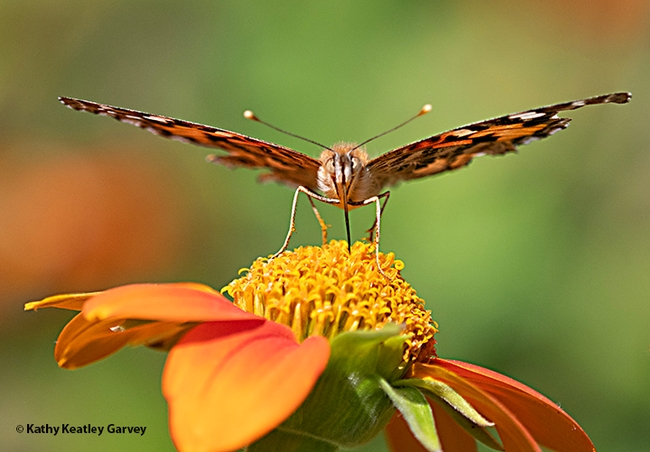When Frank Loesser (1910-1969) wrote and composed "Luck Be a Lady" in 1950, he wasn't thinking of a butterfly.
But when we spotted this Painted Lady (Vanessa cardui) in our garden this week, we knew she was lucky.
A predator, probably a bird, chunked out parts of both wings, but that didn't seem to bother her as she sipped nectar from a Mexican sunflower (Tithonia rotundifola).
If anything, her close encounter made her even more alert to her surroundings.
The orange, brown and white butterfly, so named because of its impressive colors and display, is found throughout much of the world. It migrates seasonally. Scientists say it can fly 100 miles per day at nearly 30 miles per hour.
Butterfly guru Art Shapiro, UC Davis emeritus professor of evolution and ecology who has been monitoring the butterflies of central California since 1972 and posts his research on Art Shapiro's Butterfly World, says that "Apparently the entire North American population winters near the US-Mexico border, breeding in the desert after the winter rains generate a crop of annual Malvaceous, Boraginaceous and Asteraceous hosts. The resulting butterflies migrate north."
"In good years (lots of desert rain) they may do so by billions, interfering with traffic and attracting the attention of the media," Shapiro relates on his site, noting that "2005 was one of the biggest Painted Lady years in history--perhaps the biggest, but how can we know? At Sacramento at the height of the migration butterflies were passing in one's field of vision at the rate of about 3 per second! 2006, by contrast, was a La Nina year with very little rain in the desert. The butterflies apparently gave up trying to breed there and flew north in February. They tried to breed but mostly were unsuccessful due to bad weather, resulting in only very sporadic individual sightings of their progeny in May. Northward-migrating Painted Ladies are provisioned with yellow fat and are reproductively immature."
Hail to the Painted Lady...
Attached Images:

